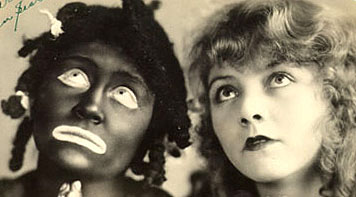
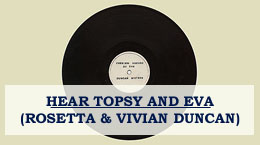
 |
 |
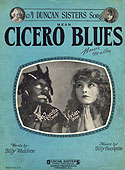
Whenever they appeared the Duncan Sisters appropriated Stowe's characters and brought them up to date. One of the more tantalizing efforts to do so occurred on the final night of the long Chicago run when the Duncans added an act entitled "Topsy and Eva Fifty Years Later." Unfortunately what happened there remains to be discovered. It is clear, however, that topicality always intruded on the story line. The most infamous example of the way current events found their way into the play involved the Duncans themselves. One Sunday during the Chicago run the sisters ventured through Cicero, Illinois, on their way back from the race track. There they were stopped by the police for a traffic violation. The result was a broken nose for Rosetta, a traffic conviction and full press coverage. Shortly thereafter the Duncans recorded "Mean Cicero Blues" and their publishing house made the sheet music available. References to the incident worked their way into Topsy and Eva and remained there during the run in New York City. When the show shifted back to Chicago at the end of June, 1927, The Tribune noted that the Duncans were "returning just in time to celebrate the anniversary of their famed encounter with the comic constables of Cicero." Certainly what the Duncans created was not Uncle Tom's Cabin. Settings and characters were taken from the novel, but Stowe might not have recognized them. A tragedy, a moral lesson, became a hybrid vaudeville-variety-musical-comedy. For a time a dying medium revived a dying text. Written descriptions of what took place when the sisters hit the boards and publicity pictures from the press remain. The available recordings of the show tunes give an occasional glimpse of the action. In the dialogue you could play at the beginning of this essay, recorded as part of a demo version of "I Never Had A Mammy" the Duncans recorded at the time of the 1942 revival of the show, the voices reveal how dynamic the duo must have been. Ironically for a musical which took such liberties with Stowe's text, the lines we hear in this fragment are taken almost verbatim from the novel. Rosetta's Topsy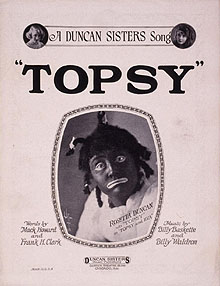
Before she hit the vaudeville circuit Rosetta Duncan spent four years as the protege of Ellen Beach Yaw. Her sights, she claimed, were set on grand opera. She would end up as a comedienne of the highest order, part of what Anthony Slide called "one of the greatest sister acts on the vaudeville stage." A mimic, a clown, a songster, adept at the ad-lib, one observer saw her as "the mistress of about every standard hoke low comedy piece of business released in the last decade, even Joe Jackson's mistaking the damp spot on the stage for a quarter." She would ride the curtain to the proscenium arch in some shows. Occasionally she took a turn at directing the orchestra. If she spotted a bald head in the first row, one could count on her making use of it somewhere in the performance. During the Los Angeles run in 1931 she was known to toss her wig to a friend in the audience at the end of the final act. Rosetta played Topsy so entertainingly that for many she personified the character. Unlike other comediennes, she had not developed a range of roles beyond her baby act and Topsy. She could adapt her Topsy to the times but could not escape the character she created. Her identity as Topsy may well be one of the reasons her career has been so sadly neglected today. As Topsy, Rosetta not only held her own, she bettered her black faced peers, Jolson, Cantor, Moran and Mack and Gosden and Correll at the game. Edward Wagenknecht, who saw the Duncans perform, put it well: Now blackface comedians are traditionally men. To give the role instead to a young and attractive girl and then have her beat her predecessors at their own game, marshalling six or seven times as much exuberance as any of them were ever able to command, in all this may not seem like a very long step to take. But it is the kind of step that makes history in the theater. Rosetta had studied the form and mastered it. Already a friend of Lew Dockstader, "one of the last and one of the greatest blackface minstrels," Rosetta covered his appearance in The Black and White Revue for The San Francisco Examiner in late 1923. Since we began Topsy and Eva, she told readers, "we have been especially interested in blackface work." Dockstader was "one of the men who created the art." "We studied every word and every bit of his action and expression." We have not yet found a script for the show, and even if we do we'll never be able to recover the lines that made Rosetta the master of the ad-lib. Whatever it was she said, her sister could never keep a straight face. Even after the show had run for two years, Vivian confessed that "when we are on the stage, we get to laughing about something, forget where we are in the play, and can't pick up our cues." "I never know what Rosetta might say. . . . It's as new to us as it is the audience." Rosetta seemed to be Topsy with a purpose. Vivian's Eva
There is a temptation to dwell on Rosetta's Topsy, indeed on Rosetta herself. She out-topsied the Topsy of the novel and of the Tom Show. The character actor became both the character and the act. Eva, however, was a far more difficult role to undertake in a musical comedy. A second banana in vaudeville parlance, Vivian could neither be Daddy Warbuck's Annie nor an angelic simpleton. If Stowe's Eva sought to save Topsy's soul, in the Duncan's version of the story Rosetta gave Eva "soul." From the first performance on it was evident that Stowe's "sickly, saintly, going-right-to-heaven sort of Little Eva" would not appear on stage. In her place was "a healthy, happy, romping, somewhat mischievous girl not trying to 'save' Topsy but to become like her." Critics recognized that Vivian could project "the last essence" of Eva's saintliness, and did, but only in support of the comedy sure to follow. Of course there were comedic moments for Eva but the punch lines were always Topsys. The Duncans' Eva had a habit of faking fainting spells. Topsy was always there to see through them and to revive her with an asafitida charm. Vivian had to look like Eva and act like a straight man. As Wagenknecht described her she was at once "romance and reality . . . a fairy child and a hard headed little girl of earth." Her job was to provide the peel for her sister's pratfalls. Strikingly when critics railed about how the show distorted Stowe's novel, seldom, if ever, was Vivian's Eva cited as an example. Off stage Vivian Duncan was known as a jokester. She drove a blue Dusenberg with needlepoint coverings, always accompanied by her Saint Bernard, parking where she pleased and picking up tickets as quickly as she drew fans. She was the mother of the team, selecting Rosetta's clothes and handling most of the personal interviews. One suspects that Topsy may have come naturally for Rosetta; for Vivian, Eva was a role to play. Topsy and Eva and the Theatre CriticsLack of fidelity with Stowe's novel was enough to put off many critics. How could Topsy and Eva be based on Uncle Tom's Cabin with no whippings, no death of "the heavenly child," no moral messages? What was one to make of it when the opening curtain revealed "a fine group of pickanney' chorus girls" singing "Old Folks at Home" and "Old Black Joe" with Uncle Tom in the lead? How could it be that Eva purchased Topsy at auction for a nickel? Such complaints would find their way into reviews in towns where more than one theatre critic made a living. 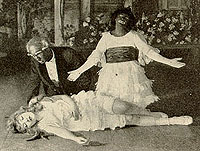
Despite nearly 200 successful performances on the West Coast and nearly a year's stay in Chicago (where box office receipts approached a million dollars), when the show reached New York the critic for Variety was appalled by what he saw. "Just how this opera managed to please the prairie dwellers so long will ever remain a conundrum hereabouts," he wrote. "Topsy and Eva is a novelty in one way," he admitted. "It is the first time any legit producer has shown courage enough to try to sell Manhattan village a composite burlesque under cork, and expect it to live up to a reputation manufactured in the broad open spaces, where space and more space seem the only answer to the cross-word puzzle of the show business." "If this one clicks," he reported, "a tea house in the Bowery ought to clean up." In short, for many Topsy and Eva wasn't Stowe and it wasn't legitimate theatre. Critics who liked the Duncan's production took both the loose relationship to the novel and the hybrid form of the play in style. "The less you know about the real Uncle Tom,'" The Boston Globe reported in 1925, "the more you are likely to enjoy his present reflection in a musical setting." "Not knowing you won't regret that there is no ice for Liza to jump across while chased by angry bloodhounds, and you won't be surprised that Little Eva, the 'heavenly child,' does not die to the accompaniment of slow music and celestial visions." In a way the Duncans were both preservationists and pioneers. Even if for purposes of publicity, during their New York run they sponsored essay contests in the local schools on Stowe's Uncle Tom's Cabin. Their creation broke all theatrical conventions. After seeing a production in Los Angeles in 1931 a reviewer reported that Topsy and Eva "is so completely naive that it baffles description. Coming under no recognizable classification -- it is a farce, melodrama, music, opera, pageantry, burlesque and dance rolled inextricably together." Could Stowe ever have imagined a day when Simon Legree cracked his whip while the London Palace Girls, costumed as pickaninnies, did the Charleston? Travesty with a Capital T: Topsy and Eva, the Movie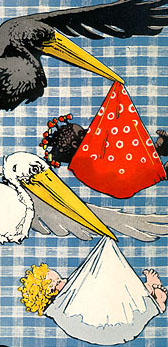
By the end of the Twenties the Duncans could demand $7,500 a week plus half the gate over $25,000 weekly take on the vaudeville circuit. Vaudeville, however, danced on tired legs. Both radio and film drew audiences and performers from one venue to another. Increasingly vaudevillians fronted film showings. In 1927 Rosetta and Vivian finally took Topsy and Eva to the silent screen. From the start of the production troubles mounted. The June, 1927, Photoplay reported "mutterings of thunder and flashes of lightning from the Topsy and Eva set" and "hints of Greta Garbo-ish temperment from the Duncan Sisters." "Stories of the untoward activities of Rosetta Duncan" circulated throught the industry. She, it seems, had "her own ideas about how pictures should be made." Before a quarter of the film was completed, production costs were "huge." "The Duncan Sisters," Photoplay noted, "apparently got as much fun fighting the production staff as they do in battling with traffic cops." Directors came and went. Del Lord, who had chauffered the Keystone Kops through many a film, came late to the director's chair. At the last minute D.W. Griffith was brought in to add bathos to slapstick. The film opened in spectacular fashion at Grauman's Eygptian in Hollywood in June, 1927. The live show before the picture lasted almost as long as the film itself. Rosetta, who estimated that she had used a ton of cork playing Topsy to that point, appeared in "a straight-blond wig . . . ending in a lot of round bouncing curls." I don't want her to go blackface this time," Vivian told a friend. On stage the Sisters sang old favorites. They mocked Aimee Semple McPherson and brought back their burlesque of grand opera. "Any of their songs are good," Louella Parsons reported; "it's not so much what the Duncans sing, as the way they sing. Their comedy is unfailing." So long as the Duncans fronted the film, it was a hit. The film by itself was not. 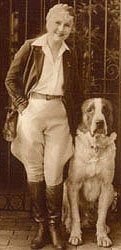
Topsy with technology proved to be too much. Parsons thought that Rosetta saved some of the Del Lord slapstick scenes. Griffith, she believed, rescued "the picture from too much horseplay." She was the kindest of critics. Title cards could not replace the ad-lib. Harmony had no place in a silent film. All that was left for the sisters was visual comedy. The film added a kind of cleverness too big for the stage and its emphasis only made the movie version even less true to Stowe's novel. When the picure opened, audiences saw a white stork racing a Doctor to the St. Claire home and "winning out delivering Eva ahead of him." Title cards moved the scene to two months later. Now a black stork raised "havoc by going through rain and lightning" to deliver Topsy. Turned away from "the homes of colored folks," the stork dropped Topsy into a barrel. Whenever slapstick was possible, slapstick appeared. Before being placed on the auction block, Topsy stole Legree's chewing tobacco and bit off a wad. Once on the block she became ill and "got rid of the cud." Near the end of the movie Topsy escaped Legree by sliding down a fence rail on a saddle, putting snow shoes on a horse, and riding across the ice flow. Instead of bloodhounds, she was chased by the family's St. Bernard. She arrived at the St. Claire's just in time to save a fortune and Eva's life. The reviewer for The Chicago Tribune, who saw the picture in September, 1927, gave his readers a mouthful of title card. The account runs: You got plenty of white angels in heaven -- hab a black one! Stop twang'n on them harps an' lissen to me! Ef ya' let L'll Missy lib Ah won' lie no mo'er. Ah won'steal no mo'er. Ah won' do nothin no mo'! Ef yo' don' want the debbill tuh get me away from yo' -- Yo bettah act quick! An' I won' ask yo' to make me white lak snow, but, jes' a nice, light tan. Topsy's prayer answered, a happy Aunt Ophlia put her in bed next to Eva and "the pair fell asleep in an affectionate embrace." The film Topsy and Eva was a box office failure. Vivian Duncan placed the blame on the studio. In her opinion the director had turned "a comedy-drama" into "a slapstick farce." "It was a sacrilege to play it as a farce," she asserted. Variety's film critic thought that when the film hit the road without the Duncans fronting it that "its best chance" for an audience would be "the kiddies." It will, he argued, "be able to repeat at special kiddie shows." Topsy and Eva as Educators The Duncans, kiddie specialists themeselves, marketed Topsy and Eva to children as well as to adults. With nine, and sometimes ten, shows a week, it often played three afternoons as well as every evening. From the play's first performance in San Francisco critics described the show as clean, wholesome entertainment for youngsters. Advertisments often made children target audiences. During their appearance on the New York stage in the mid Twenties the sisters sponsored an essay contest for grade school students reportedly to revive interest in American literature. Not surprisingly the first book suggested for review was Uncle Tom's Cabin. The cast served as judges and the prize, tickets to Topsy and Eva. When the show returned to Chicago in the late summer of 1925, gifts were offered to children attending afternoon performances. During the second Los Angeles run, advertisements welcomed youngsters back stage after the performance. Advertisements for the film and stage appearance proclaimed "Your Children Will Never Forgive You if they don't get to see this combination." The importance of the pitch to children ought not be overlooked simply as an advertising ploy. The show for most was their only contact with Uncle Tom's Cabin. A review of the stage play by The Boston Globe critic in 1925 suggests even broader implications. The writer pointed out that while "every American" had heard about Uncle Tom's Cabin, it was unlikely that "more than a small percentage of the present younger generation of theatre goers in the large cities of the country have ever witnessed a performance of the play" -- let alone read the novel. Although Tom Shows had been produced "more than 200,000 times since civil war days" for the "small towns in America," Topsy and Eva was a show designed for metropolitan audiences, for a new generation in a new location. It would work for those with fading memories of the past and for those who really had no past at all when it came to Stowe's thesis. In a way Topsy and Eva became the origin story for those who had neither read the novel nor were aware of its aims. As the play went through revival after revival it evoked memories of earlier productions, not of Stowe. Nostalgia became a drawing card and the Duncans played it well. During the third run in Los Angeles in 1931, they called on those in the audience who had seen it in the previous decade and asked them to stand. Topsy and Eva applauded them. Given the way the Duncans worked, the same ploy most likely was employed during the World's Fair revival in Chicago and during the final run in 1942. The longer the Duncans appeared as Topsy and Eva, the more its hit song " Remembering" resonated with the show. Almost from the beginning audiences came to see the Duncan Sisters in Topsy and Eva, not Stowe's Topsy and Eva. In the process they came away happy with the Sister's variant of the novel. In a sense, drawn into remembering, they left forgetting. A Funny Thing Happened On The Way To Interpretation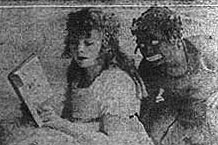
One ought to be cautious when seeking meaning from the Duncan Sisters' career as Topsy and Eva. While interpretations of Stowe's novel may have changed over time, the novel itself did not. Topsy and Eva is another matter. All the available evidence suggests that although the framework for the musical may not have altered much, the content, from jokes, to songs, to dances, to cast size, went through a variety of revisions, sometimes even in the same run. While programs listing scenes and songs and dances in order can be found, they give the barest of descriptions of a comedy whose success rests on Rosetta's ad-libs as much as anything else. True, the 1927 film is extant, although not readily available, but Vivian branded that text as a sacrilege. The task of coaxing meaning from their Topsy and Eva is all the more complicated by the Duncans also assuming the roles in vaudeville routines. What, for example, is one to make of Rosetta's appearance at the Palace in May, 1931, on a bill headed by Ed Wynn? There in Topsy's "blackface make-up" she sang "Zwei Herzen im Drei-Viertel Tank." She was "impish as ever," The New York Times critic noted. No where is the danger of imposing an ideological set on the text the Duncans' left more evident than in the case of the 1927 film. Much of what constitutes modern interpretation often says more about the critic and his or her social circumstance than it does about the text itself. Two examples will suffice. Both use only the film as text. Writing in the 1970s, Phillip Zito, then editor of The American Film Institute Catalog, described Topsy and Eva as "the most extreme and racist of the silent films preserved by the AFI." Although he ascribed the role to the wrong sister, Zito branded the performance as "one of the most damning examples of racist portraiture in American film." Topsy, as he saw her, was "ignorant, thieving, superstitious, undisciplined, given over to swearing and biting; she eats bugs picked from flowers and butts heads with a goat. And she is dirty . . ." For Zito, the film was "about a black character redeemed by becoming white in all things except color. And color was the one thing that will never wash away." In a recent article for The Drama Review entitled "Uncle Tom's Cabin: Before and After the Jim Crow Era," Michele Wallace assigned another, and quite different, meaning to the film. Wallace asserted at the outset that "she chose not to study" silent film but rather "it chose me through the natural inclination of the depressive to always choose that which will reinforce and consolidate her negative self-assessment and her pessimistic mental state." Perhaps because of her mind-set. she read Topsy and Eva quite differently than Zito. For her the film was "wonderful." "The plot," she contended, takes "bizarre comic liberties with Stowe's scenario and Topsy and Eva become all but lovers." Wallace's Topsy is "heroic, adventurous and an absolutely delightful trickster-figure." "In a nutshell," she concluded, "the story here is not about the love affair between Uncle Tom and Little Eva, which James Baldwin and other male commentators directed our attention to, but rather the love affair between Topsy and Little Eva." |
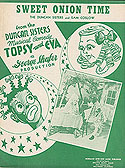 1942 SHEET MUSIC |
The contradictions evident in these two readings of the stablest version of the text cry out for simpler explanations of the totality of the Duncans' work as Topsy and Eva. It is tempting to see Topsy and Eva, in all its variants, in terms of race, gender and class. Doing so, however current it may be, misses more basic, and perhaps more meaningful, areas of exploration. Just how did Topsy and Eva manage to survive in a rapidly changing media environment? What allowed for public acceptance of Stowe's novel as a musical comedy? Why is Rosetta Duncan, hailed as a, if not the, premier comedienne in her own time, now neglected, if not forgotten? |
| FIGURE CREDITS: 8. Courtesy the Harvard Theatre Collection, The Houghton Library; 10. From The World's Greatest Hit, by Harry Birdoff (Vanni, 1947); ALL OTHERS. From the collection of the author. |